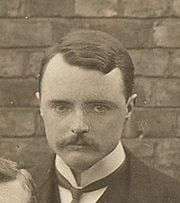Ernest Kennaway
| Sir Ernest Laurence Kennaway | |
|---|---|
 | |
| Born |
23 May 1881 Velwell Villas, Exeter |
| Died |
1 January 1958 (aged 76) St. Bartholomews Hospital, London EC1, England |
| Nationality | United Kingdom |
| Fields | Pathology |
| Alma mater |
University College London University of Oxford |
| Known for | Discovery of the first pure compound to show carcinogenic activity |
| Notable awards | |
Sir Ernest Laurence Kennaway FRS[1] (23 May 1881 – 1 January 1958) was a British pathologist and Royal Medal winner. He first became interested in natural life when, due to a childhood illness, he was encouraged to spend time outdoors.[2] He was trained at University College London, and in 1898 was accepted into New College, Oxford on an open scholarship to study natural sciences. He graduated with a B.A. in 1903, and after three years at Middlesex Hospital he completed a Bachelor of Medicine and Surgery. After graduating he worked for The Lister Institute for Preventive Medicine and UCL before returning to Oxford, this time to Brasenose College on a Hulme scholarship in 1909. He became a Travelling Fellow of Brasenose in 1910, a Doctor of Medicine in 1911 and a Doctor of Science (specifically physiological chemistry) in 1915.[2]
In 1909 he became a physiology demonstrator at Guy's Hospital, where he remained until he was made head of the department of chemical pathology at the Bland-Sutton Institute of Pathology in 1914. As head of department he conducted research into purine metabolism and ketonuria, proving in 1921 that the carcinogen in coal was a cyclic hydrocarbon. In 1929 he discovered the first pure compound to show evidence of cancer-causing activity, 1:2:5:6-dibenzanthracene, and also discovered a series of other carcinogenic hydrocarbons including methylcholanthrene.[2] In 1930, Kennaway and Izrael Hieger showed for the first time that single polycyclic aromatic hydrocarbons (PAHs), such as dibenz[a,h]anthracene, are tumorigenic in mouse skin.[3] Between 1932 and 1942 he published six articles on these discoveries in the Proceedings of the Royal Society.
After the death of Professor Archibald Leitch in 1931 Kenneway became professor of chemical pathology at the University of London, where he remained until his retirement in 1946.[2] He was awarded the Royal Medal in 1941 "For his discovery of the nature of the carcinogenic substances in coal tar and for his investigations on production of cancer by synthetic substances."[4] and was knighted in 1947. For over thirty years he had suffered from Parkinson's disease, and this eventually killed him on 1 January 1958.[2]
References
- 1 2 Cook, J. W. (1958). "Ernest Laurence Kennaway 1881-1958". Biographical Memoirs of Fellows of the Royal Society. 4: 138. doi:10.1098/rsbm.1958.0013.
- 1 2 3 4 5 "Oxford DNB article:Kennaway, Sir Ernest Laurence". Retrieved 2008-11-03.
- ↑ Andreas Luch, "Nature and Nurture - Lessons from Chemical Carcinogens", Nature Journals, February 2005
- ↑ "Royal archive winners 1949–1900". Retrieved 2008-11-04.